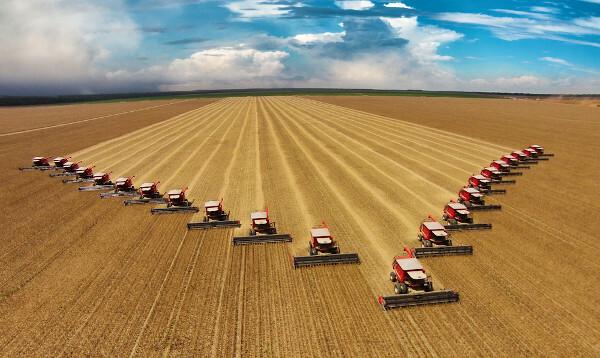You transgenic foods are produced using genetically modified organisms (GMO), such as seeds, with genetic engineering techniques. These techniques were introduced in farming from the second half of the twentieth century with the Green Revolution, becoming important for the development of more productive crops that are resistant to diseases, pests and climatic adversities. The increased consumption of transgenics, however, raises discussions about their negative impact on human health and on the environment, as well as questions about human intervention in nature.
Read too:Gene therapy — genetic modification which can treat hitherto incurable diseases
Topics of this article
- 1 - Summary on transgenic foods
- 2 - What are transgenic foods?
- 3 - Discussion on transgenic foods
- 4 - Advantages of transgenic foods
- 5 - Disadvantages of transgenic foods
- 6 - Risk of transgenic foods to health
- 7 - Legislation on transgenic foods
- 8 - Transgenic foods in the world
- 9 - Transgenic foods in Brazil
Summary about genetically modified foods
Transgenic foods are altered in the laboratory to introduce characteristics that would not naturally be developed by a given organism.
Pest resistance and illnesses, tolerance to climatic adversities, increase in nutritional content and greater productivity are some of the transformations promoted through changes in food genes.
They emerged from the Green Revolution, which introduced genetic engineering techniques in agricultural production.
Health and socioeconomic issues, ethics in science and the role of large companies in the agribusiness in the economy are some of the discussions raised by the use of transgenic foods.
Transgenics increase food production and are more resistant to external agents (biological and climatic). However, they can cause damage to the environment and human health.
O Brazil is the second largest producer of transgenic foods in the world, second only to U.S. Among the main transgenic crops in Brazil are soy and corn.
What are transgenic foods?
It is called a transgenic artificially altered food, in the laboratory, for the introduction of genes responsible for conferring new characteristics to that particular organism. Such characteristics would not be developed naturally and are selected according to the need identified by the rural producer or even by the agribusiness companies. Transgenic foods are also called genetically modified organisms (or GMOs).
To the modifications in food are made with the aid of genetic engineering techniques that were introduced in agriculture from the second half of the twentieth century with the advent of the Green Revolution. Among the properties that are introduced into organisms through this set of techniques are resistance to pests and diseases, increased productivity, increased nutritional value and greater tolerance to adversity weather.
Do not stop now... There's more after the publicity ;)
Discussion about genetically modified foods
Genetically modified organisms have, since their emergence, raised a series of debates in society regarding the ethical principles of science and economic and social issues. While many analyzes consider transgenics an important advance in the scientific and socioeconomic field, others see the production of these organisms as a practice harmful to the environment and address the risk to human health represented by this type of food.
You limits of science and, mainly, of human action on natural organisms are some of the discussions proposals in the ethical field. The technique for developing transgenic foods involves altering the genetic material of these organisms (DNA) and is applied to plant species and also animals, as in cattle. With this, human intervention in nature and the impacts of these actions on the maintenance of biodiversity and the balance of the environment are questioned.

Economically, the commercialization of transgenics is restricted to a group of large agribusiness companies. Most of the time, the sale of seeds and embryos is associated with what is called a technological package, which includes products such as fertilizers and proper pesticides that should be used with the new strains of organism.
The discussions in this case involve the concentration of profits and the monopoly exercised by these companies in the market, which also falls on the question of the type of competition that is created between large producers that use these technological packages and small farmers. Furthermore, it discusses the harm to health that transgenics represent and the role of these large companies in introducing such food varieties to the market.
GM foods can also be seen as a long-term solution to the food insecurity, a situation faced by 2.3 billion people worldwide. However, although the costs of these foods are lower, their use comes up against discussions about the potential risks offered by transgenics to human health.
Read too: Environmental contamination by pesticides
Advantages of GM foods
The use of transgenic varieties of crops and other products can offer advantages to both the rural producer and the final consumer, such as:
improvements that show greater resistance to fungus, diseases and pests;
increase in the total amount of nutrients present in a given food;
higher crop productivity;
increase in food production;
resistance to climates adverse or extreme weather events;
possibility of adaptation for planting in soils considered unsuitable (such as soils acids);
lower cost of products for the final consumer, that is, the general population.
Disadvantages of GM foods
Genetically modified foods have disadvantages for the environment and human health. Among them, we can mention:
Impacts on pest control, providing the development of species that are more resistant to the action of pesticides and that can negatively affect organic crops.
Water pollution It is of soils by the increased use of agricultural pesticides.
Loss of biodiversity due to the damage it can cause to animals, such as insects, and the contamination of organic species as a result of natural processes, such as pollination. This is also due to the increase in areas planted with monocultures.
Damage to human health, such as increased allergies.
Risk of genetically modified foods to health
The main concern about the ingestion of transgenic foods is associated with the potential health risks that the modified organisms can cause to humans.
The first one is the onset of allergiess the introduction of new genes in food and the production, in these organisms, of proteins It is amino acids that can trigger a reaction when ingested. Resistance to antibiotics is another issue that poses a risk to health and can be caused by the recurrent consumption of antibiotics. transgenic, according to the Brazilian Institute of Consumer Defense (Idec).
Legislation on genetically modified foods
The regulation of activities involving transgenic organisms in Brazil, including those intended for food, is done through the Lhey noº 11.105, March 24, 2005. The Biosafety Law, as it is known, establishes the parameters for the research, manipulation and commercialization of these organisms with the aim of ensuring the protection of human beings and all other forms of life, animal or plant, and the environment environment.
In this way, all transgenic foods that reach the Brazilian market were evaluated according to the criteria established by the Biosafety Law, must be approved byThe National Technical Commission on Biosafety (CTNBio) before being sent to the final consumer.|1|
Transgenic foods or products containing transgenic components (above 1%) must be identified on their packages, since the final choice must be made by the consumer. This identification appears in the form of a yellow triangle inside which is a capital T in black.
GM foods around the world
GM foods are produced by over 60 nations worldwide. Most GMO producing countries are those with economies emerging (or under development), and their crops represent little more than half of the total areas planted with transgenic crops.
You United States and Brazil are the world's two largest producers of transgenic foods. The area planted with GMOs in these countries reaches 70 and 30 million hectares, respectively. Among the main crops developed are those that we classify as commodities crops: soy, corn and cotton. Other major producers are Argentina, India, Canada, China, Paraguay, Pakistan and South Africa.
Read too: rural environmental problems
GM foods in Brazil

Brazil is the world's second largest producer of genetically modified foods, as we saw earlier. The area planted with genetically modified species reaches 30 million hectares and its flagship is soy. This grain is among the main Brazilian export products, and it was through it that the planting of transgenic foods developed entirely in the country began.
The Brazilian Agricultural Research Corporation (Embrapa) was responsible for the first variation of Brazilian transgenic soy. Twenty years of research have resulted in a seed designed to have greater tolerance for a particular type of herbicide.|2| which was placed on the market in 2015.|3| A Embrapa is currently working on new soy variants as well as food and raw materials such as coffee, sugar cane and cotton.
O corn is another food planted and marketed in Brazil and which has many crops developed with genetically modified seeds.
The history of transgenic production in Brazil began during the 1990s, with the importation of modified soybean seeds from Argentina. The product was not immediately approved, and its marketing had been authorized by means of a provisional measure in 1995, but which was suspended three years later. Brazilian legislation for the regulation and inspection of these organisms in the national territory was approved in 2005, and the country currently has around 50 GMOs on the market.|4|
Grades
|1| EMBRAPA. Transgenics: breaking barriers in favor of Brazilian agriculture. Available here.
|2| Idem.
|3| LANDGRAF, Lebna. First totally Brazilian transgenic soy arrives on the market. Embrapa News, 28 Aug. 2015. Available here.
|4| NEVES, Mary. Special report: Transgenics: Brazil is the world's second largest producer. Rádio Câmara, [S.I.]. Available here.
By Paloma Guitarrara
Geography Teacher
Know what agribusiness is. Understand about this economic practice in Brazil. Know the advantages and disadvantages of this type of activity.
Find out why there is so much resistance to the use of transgenics.
Some arguments of those who are in favor of the use of transgenics.
Understand the Green Revolution and its aftermath. Know its characteristics as well as its origin and initial objectives. See when she arrived in Brazil.



